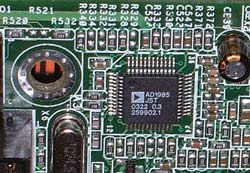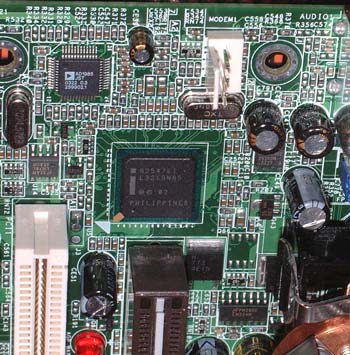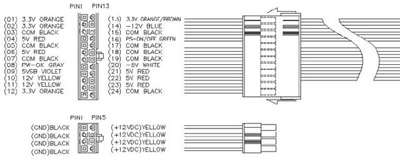Asus PC-DL Deluxe: 875 with Dual Xeons
by Wesley Fink on September 6, 2003 12:06 AM EST- Posted in
- Motherboards
Asus PC-DL: Basic Features
| Asus PC-DL Motherboard Specifications | |
| CPU Interface | Dual Xeon Socket-604 |
| Chipset | Intel 875P North Bridge Intel ICH5R South Bridge |
| Bus Speeds | 133 to 165 (in 1MHz increments) — 533FSB |
| Core Voltages Supported | Default only |
| AGP Voltages Supported | Default only |
| DRAM Voltages Supported | Default only |
| Chipset Voltage | Default only |
| CPU Multiplier Ratios | To 23X with 3.06 CPU |
| Memory Slots | 4 x 184-pin Dual-Channel DDR DIMM Slots Supports both Standard and ECC Memory to PC2700 (DDR333) |
| Expansion Slots | 1 AGP 8X Slot 5 PCI Slots |
| Onboard IDE RAID | Standard ATA 100/66 Supporting up to 4 IDE devices |
| Onboard USB 2.0/IEEE-1394 | 8 USB 2.0 ports supported by ICH5R 2 TI TSB43AB22A Firewire |
| Onboard LAN | Intel 82547EI CSA Gigabit LAN |
| Onboard Audio | ADI AD1985 6-channel |
| Onboard Serial ATA | Intel ICH5R supporting 2 SATA drives Promise PDC20378 for 2 SATA drives |
| Onboard RAID | Intel ICH5R SATA RAID 0,1 Promise 20378 SATA & IDE RAID 0,1, 0+1 |
| BIOS Revision | Release BIOS 1002 |

The feature list certainly looks more like a top-end consumer motherboard than a server board. In fact, the features are basically the same as the P4C800-E that we recently reviewed.

Asus has used the ADI 5.1 audio codec that has become standard on most of their recent boards. ADI is the same codec used by Intel on their 875 boards, and provides automatic switching of sound inputs. In addition, Asus has included a bracket with both coaxial and optical SPDIF out for connection to digital receivers or powered speakers. This is certainly not the kind of on-board audio you would normally expect to find on a Dual processor board.

On-board LAN is provided by Intel’s Gigabit LAN chip providing LAN support on the dedicated CSA bus.

4 USB 2.0 ports are included on the I/O panel with headers for 4 additional USB 2 ports on the motherboard, for a total of 8 USB 2.0 ports provided by the Intel ICH5R South Bridge. Asus provides an accessory bracket with 2 USB ports and a game port. 2 IEEE1384 Firewire ports are available, with one on the I/O panel and one provided on an included accessory bracket.

Serial ATA support is available from both the ICH5R South Bridge and the Promise 20378 controller. Up to 4 individual SATA drives or various combinations of Intel and/or Promise RAID are available. In addition, Asus provides an additional Promise IDE connector that supports up to 2 single drives or 2 ATA133 IDE drives in a RAID configuration. Asus includes four SATA cables, and the 2 sets of power splitters/adapters to allow convenient connection of up to 4 Serial ATA drives.

The Asus PC-DL provides standard IO options on the back panel, plus a firewire port, Gigabit LAN port, and 4 USB 2.0 connectors. A dedicated IO backplate is included. The mini jacks appear to be the standard line-in/line out/mic jacks, but in fact, they automatically configure themselves depending on what you plug into the jacks.
To this point, we could be talking about features on the P4C800-E, but there are several features that immediately tell you this is a Dual Xeon board.
While the PC-DL is a standard ATX configuration and fits the same cases as regular single-processor boards, you will still need a workstation/server power supply. The standard ATX power connector is 20-pin with a 4-pin 12V connector. The PC-DL requires a 24-pin power connection and the 8-pin connector only available on Xeon power supplies.
Click to enlarge.
Fortunately, there are several commonly available power supplies that will meet the requirements. The Vantec Aluminum Stealth 470W and 520W power supplies come with a 24-pin power connector plus a converter for standard 20-pin ATX. Also included are both the standard 4-pin 12V and the 8-pin connector required for Dual-Processor/Server boards like the PC-DL. In addition, both Enermax and Antec have Xeon-style power supplies available at about $50 more than a standard ATX power supply. We do like the Vantec feature of being able to use their power supply for both regular ATX boards and Xeon boards.
Early information about the PC-DL talks about the overclocking capabilities of the board. While the promise is certainly here, the current talk is overly ambitious in our opinion. The only overclocking adjustments on the current board/BIOS combination are FSB adjustment from 133 to 165 and the ability to use a lower multiplier with 3.06 Xeons. Without PCI/AGP lock and any voltage controls at all, even these features are of limited value. When we compare the components used on the PC-DL to those on top P4 boards, it is clear that Asus can provide more of these overclocking features with BIOS updates in the future. However, as it is currently shipping, any claims you see about overclocking are from those accustomed to seeing no overclocking controls at all on a Xeon board. Compared to a standard high-end Pentium 4 board, overclocking options are very limited.











29 Comments
View All Comments
Kiwi42084 - Tuesday, March 2, 2004 - link
This Benchmark is totally unfair!!!!!The PC-DL has the avalibility to produce 4 usable CPUs...2 Physical and 2 Logical....
Windows XP will only see 2 of these. The benchmarks are being done with Half of the POWER POTENTIAL.
vppaul - Wednesday, February 25, 2004 - link
I am having a problem with my PC-DL board. The System Management BIOS is reporting that there is 4096 MB of RAM, but Windows reports that 2048 MB is available. Anybody ideas? I am trying to get help from Asus tech support but any help would be appreciated. Running dual 3.06 with 4 x 1GB sticks.piperfect - Monday, February 23, 2004 - link
I totally agree with FutureShock999. Why not run several instances of the a divx encoder. For instance do a 2 part movie on an encoder that runs two threads per instance then run both of the parts at the same time in two instances of the program on the xeon and see who finishes first. What you guys are doing is like comparing an f-16 fighter jet to a f-15 and saying the f-15 can only use one of its engines.piperfect - Wednesday, February 11, 2004 - link
I got my pc-dl with 2.8GHz Xeons with raptor drives in RAID0 to 3361MHz 160FSB with a dram clock of 200MHz. 4:5 It ran Sandra burnin overnight. Maybe my board is a newer revision. I read this article after I bought the Raptor so I didn't try to overclock it until yeaterday but it did and it runs well!!!!!FutureShock999 - Monday, October 6, 2003 - link
Wesley,A nice review, but I believe the wrong benchmarks. No one should buy a dual-processor machine to execute a single-threaded application faster, especially when that single proc is slower than others on the market. Dual-proc boards are bought to do multi-threaded stuff, either runnig a single multi-threaded application, or running several different single-threaded applications. In no place did I see benchmarks that explicitly looked like that.
As such, your review was a good cautionary tale for people that didn't KNOW the above, and hopefully will stop some people from spending a lot of money on a this board hoping to have a great UT setup.
Now if you had shown what it was like to play a game, encode media, and download a few gigs of content SIMULTANEOUSLY, then we could really see how this board stacks up to the competition you evaluated it against. And I think it might have beaten them rather handily...
Wesley Fink - Tuesday, September 9, 2003 - link
#23 -We recently changed our standard video card from nVidia's Ti4600 to the ATI RADEON 9800 PRO. Theoretically this should have no impact on encoding scores, but we reran all benchmarks with our new standard hadware on a few of the highest performing boards. Evan ran about half the new encoding benchmarks on the west coast, and I ran the other half on the east coast. As you can see our new results compare very well to each other.
I have no other explanation, but perhaps Evan can shed some light on this. I have used the new ATI Radeon 9800 PRO from day 1 and my benchmarks have been cumulative over the last couple of months with no dramatic change that you point out.
Anonymous User - Tuesday, September 9, 2003 - link
The 865/875 P4 boards in this test all perform 50% faster in the media encoding benchmark in this review than they did in the round-up a couple weeks ago.Has anyone else noticed this dicrepancy? The Abit IS7-G has gone from 64.45 fps to 104 fps. Both times they used a P4 3.0Ghz, 800mhz FSB, with HT enabled. Nothing seems to have changed except the encoding speed. I wish I could do that to my rig ; )
A 50% increase in as linear and consistent a benchmark as DivX encoding is simply astounding.
I just wanted to point this out to everybody around here.
Thank you for your time.
Anonymous User - Tuesday, September 9, 2003 - link
It' will not overclock with the SATA drives on the intel controller. BUT it will if you run them on the onboard promise controller. I have 2 WD Raptor's running RAID0 and the 2800/533's running @3250 100% stable.Anonymous User - Monday, September 8, 2003 - link
Which brings up the question about whether or not HT was enabled on it. And the fact is they used a regular consumer card for video Most workstations would have a workstation class card in them such as a Quadro, FireGL, or even a 3DLabs card in them. It all depends on the applications that one uses. Most normal people wouldn't use a dual machine for gaming anyways. They'd use them for graphical processing or media encoding or file serving and such. Just talk to those guys over at 2CPU.com they know what I'm talking about. ;)Anonymous User - Monday, September 8, 2003 - link
From the looks of it, there would be little if any reason to spend gobs of extra money on a system that is beat by AMD in gaming, and by single P4 siblings in high-end workstation tasks.